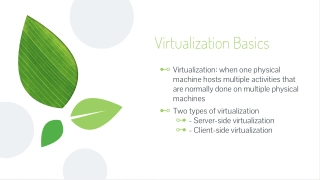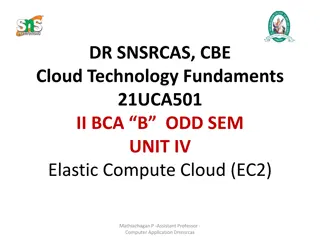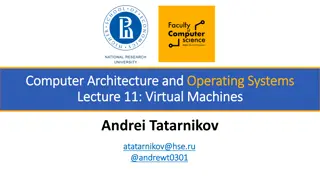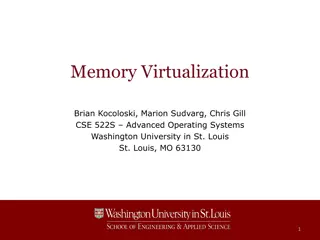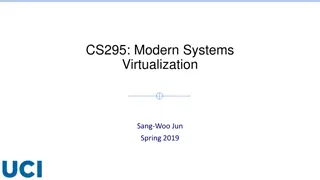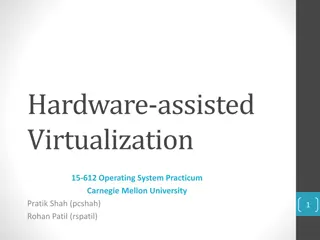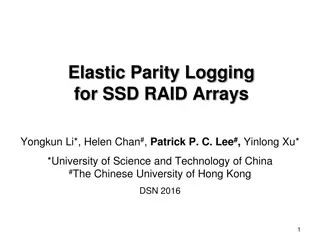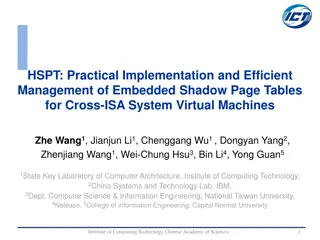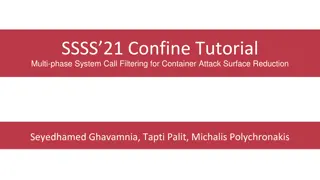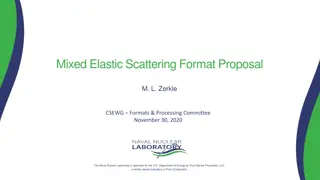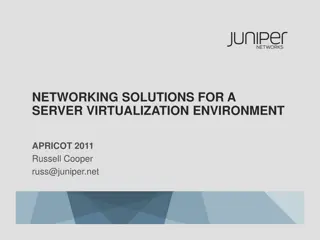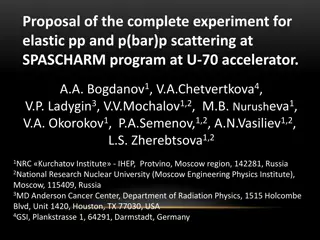Elastic Security Virtualization with vNIDS
Explore the concept of Elastic Security through Safe and Efficient Virtualization of Network Intrusion Detection Systems using vNIDS. This study delves into the challenges of traditional NIDSes, the requirements for virtualized environments, traffic volume variations, new trends in network function virtualization, and the benefits of Elastic Security NIDS virtualization. Discover the importance of flexible location and capacity for scalable and flexible network security functions.
Download Presentation

Please find below an Image/Link to download the presentation.
The content on the website is provided AS IS for your information and personal use only. It may not be sold, licensed, or shared on other websites without obtaining consent from the author.If you encounter any issues during the download, it is possible that the publisher has removed the file from their server.
You are allowed to download the files provided on this website for personal or commercial use, subject to the condition that they are used lawfully. All files are the property of their respective owners.
The content on the website is provided AS IS for your information and personal use only. It may not be sold, licensed, or shared on other websites without obtaining consent from the author.
E N D
Presentation Transcript
vNIDS: Towards Elastic Security with Safe and Efficient Virtualization of Network Intrusion Detection Systems Hongda Li1, Hongxin Hu1, Guofei Gu2, Gail-Joon Ahn3, and Fuqiang Zhang1 3 3 2 1 CCS 2018
Traditional NIDSes Multi-thread Clustered Multi-thread GPU Acceleration Multi-thread GPU Acceleration
Traditional NIDSes Multi-thread Clustered Address scalability issue: Multi-core/thread Cluster Multi-thread GPU Acceleration Limited in flexibility: Fixed location Constant capacity Multi-thread GPU Acceleration
Requirement 1: Virtualized Environments Virtualized Network Zones Blur & Fluid Perimeters Zone1 Zone2 Zone3 Service Migration Datacenter2 Datacenter1 Datacenter3 Infrastructure
Requirement 2: Traffic Volume Variation Expensive option: DDoS attack on Feb. 2016 capacity peak traffic load Gbps 400 320 240 Significant Variation 160 80 0 2/19 2/22 2/25 Time Source: https://blog.cloudflare.com/a-winter-of-400gbps-weekend-ddos-attacks/
New Trends Network Function Virtualization (NFV) Software instances Software-Define Networking (SDN) Dynamic traffic steering Virtualization Platform SDN Switch Elastic Security NFV SDN
Elastic Security NIDS Virtualization: flexible location & capacity Scalable and Flexible network security functions Existing Work VFW Controller (NDSS 17) Bohatei (USENIX Sec 15) PSI (NDSS 17)
vNIDS enables safe and efficient NIDS virtualization Safe Virtualization: does not miss attacks Efficient Virtualization: provisioned optimally
Ch. 1: Effective Intrusion Detection Missing Malicious Activities Instance2 Instance1 SIP=10.1.1.1 SIP=10.1.1.1 SIP=10.1.1.1 SDN Switch Scanner Detector
Ch. 1: Effective Intrusion Detection Multi-flow State Per-flow State Shared Data Store Instance2 Instance1 How to distinguish per-flow and multi-flow states?
Ch. 2: Non-monolithic NIDS Provisioning Inefficient Resource Allocation Can t fit 3 2 Monolithic NIDS Instance Virtualized NIDSes: Allocate and deallocate more frequently Cloud
Ch. 2: Non-monolithic NIDS Provisioning Inefficient Scaling Detector2 Detector1 Overloaded NIDS Engine Detector2 Detector1 Over-provisioned Scale slow Monolithic NIDS Instance NIDS Engine Detector2 Detector1 Virtualized NIDSes: NIDS Engine Scale more frequently
Ch. 2: Non-monolithic NIDS Provisioning Non-monolithic Provisioning Monolithic Provisioning General How to decompose? Fine-grained How to enforce detection logics?
vNIDS Architecture Overview Detection Logic Programs 1. program analysis vNIDS Controller Effective Intrusion Detection Detection State Classification State Management vNIDS Microservice Instances 2. detection state sharing Shared Data Store Shared Data Store Shared Data Store
vNIDS Architecture Overview Detection Logic Programs 4. program slicing vNIDS Controller Effective Intrusion Detection Non-Monolithic NIDS Provisioning Detection State Classification Detection Logic Program Partitioning State Management Provision Control 3. microservices vNIDS Microservice Instances Payload-based Detection Instances Header-based Detection Instances Protocol Parse Instances Shared Data Store Shared Data Store Shared Data Store Header-based Detection Microservice Payload-based Detection Microservice Protocol Parse Microservice
Scope of Detection States Flow record Essential data structure of NFs Lifetime Determines scope of detection states Always freed before a flow record is freed Dedicated to a certain flow Not always freed before a flow record is freed Must be freed by other flows
Inferring the Scope of Detection States Compute the CFG of the detector
Inferring the Scope of Detection States Compute the CFG of the detector Compute dominator of statement T Flow record is freed here (Statement T)
Inferring the Scope of Detection States Entry point Compute the CFG of the detector Compute dominator of statement T Dominator of T Statement T
Inferring the Scope of Detection States Entry point Compute the CFG of the detector Compute dominator of statement T Multi-flow detection state Dominator of T Statement T Per-flow detection state
Logic Structure of NIDSes Various detection tasks Detection Logics Application Protocol Parsers Payload parsing Network Traffic Network Protocol Stack Network layer processing Monolithic NIDS
Types of Detection Logics Only inspect header Not rely on APPs Type-II Detection Logics Type-I Application Protocol Parsers Network Traffic Inspect header & payload Need APPs Network Protocol Stack Monolithic NIDS
Decomposing NIDSes Monolithic NIDS Type-II Detection Logics Type-I Application Protocol Parsers NIDS Decomposed as Microservices Network Protocol Stack Type-II Type-I Application Protocol Parsers Detection Logics Detection Logics Network Protocol Stack Network Protocol Stack Network Protocol Stack Payload-based Detection Microservice Header-based Detection Microservice Protocol Parse Microservice
Detection Logic Program Partitioning 1 Detection Logic Program 2 4 3 Partitioned DLPs
Implementation & Evaluation Implementation Xen hypervisor Frama-C framework for program analysis Click for microservices and DLPs RAMCloud for detection states sharing Evaluation CloudLab Real-world dataset + generated attack traffic
Effectiveness of vNIDS Bro vNIDS Share All No Share Bro vNIDS Share All No Share Bro vNIDS Share All No Share Malicious Activity Detection Rate (%) Malicious Activity Detection Rate (%) Malicious Activity Detection Rate (%) 1.2 1.2 1.2 1 1 1 0.8 0.8 0.8 0.6 0.6 0.6 0.4 0.4 0.4 0.2 0.2 0.2 0 0 0 CAIDA+Attack.trace LBNL+Attack.trace Campus+Attack.trace * Detect all malicious activity: Bro, Share All, and vNIDS * Miss malicious activities: No Share
Performance Improvements by Detection State Classification Processing Time saved by vNIDS (%) No Sharing vNIDS Share All Packet Processing Time (microsecond) Packet Processing Time Reduced (%) 120 800 700 100 > 50% 600 80 500 60 400 300 40 200 20 100 0 0 * Reduced processing time: for all six detection logics * Reduced rate: more than 50%
Efficiency of Microservices 700 Launch Time (millisec) Header-based Detection 600 500 400 Protocol Analysis 300 200 Payload-based Detection 100 0 Monolithic * Monolithic NIDS: launch slower * Microservice: scale faster
Flexibility of vNIDS Traditional NIDS Instances Internet Rerouted Traffic Site-2 (Wisconsin) Site-1 (Clemson) AAA BBB BBB
Flexibility of vNIDS Virtualized NIDS Instances Internet Rerouted Traffic Site-2 (Wisconsin) Site-1 (Clemson) AAA BBB
Flexibility of vNIDS Virtualized NIDS Instance-B Virtualized NIDS Instance-A Internet Communication Traffic Site-2 (Wisconsin) Site-1 (Clemson) AAA BBB
Flexibility of vNIDS Reduce by 99.9% in the best case Reduce by 58.3% in the worst case
Flexibility of vNIDS Runtime throughput of vNIDS and Bro Cluster Adjustable Resource Consumption Number of instances of vNIDS and Bro Cluster
Conclusion and Future Work Make a further step towards elastic security Safe and efficient NIDS virtualization Effective intrusion detection Non-monolithic NIDS provisioning Implementation and Evaluation 3 microservices & 6 detection logic programs Extensive Evaluation of vNIDS Future work More fine-grained microservices Generalize our approach for other security and non- security NFs
Q & A hongdal@clemson.edu Clemson University


